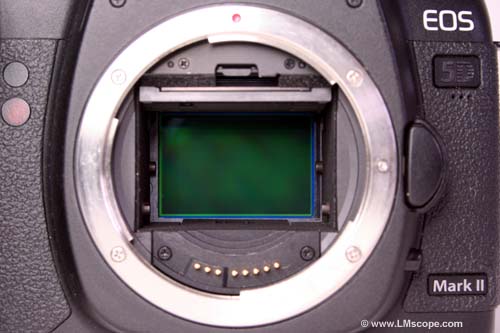

Canon EOS 5D Mark II on the microscope
Since the Canon EOS 5D Mark II has been the undisputed leader in our camera ranking for more than two years it was high time to publish a comprehensive test review of this camera.
The Canon EOS 5D Mark II is a highly popular camera that has attained a certain degree of cult status in photography circles. It is equipped with a full-frame sensor (24 x 36 mm) with 21 megapixels and comes with many other professional features. In the current market, the camera is available for a price from EUR 1,850.00 upwards.
Let’s start our test review with the most prominent feature: the camera body. With a weight of 950 grams, the body is definitely not on the light side. It boasts excellent build quality (almost no gaps at all) and is fitted with rubber seals to keep the camera water and dust proof. As a result, even working outdoors in inclement weather conditions does not pose a problem at all. The display size is equal to the displays on other camera manufacturers’ models but cannot, unfortunately, be swivelled in all directions such as, for example, that of the Olympus E-5.
The set-up of the camera is very user-friendly, and the “My Menu“ function makes it even more convenient as it allows the user to place the menu options he/she uses most under one tab. The EOS 5D Mark II is mostly controlled via the Multi-Controller (a small joystick at the back of the camera) and two control dials.
A particular handy feature for use in macroscopy and microscopy is the HDMI interface, which enables the camera user to display a preview in Live View mode on an HDTV monitor. This not only simplifies the work flow as such, but also makes it possible for several persons to work together on one object.
Remote control is also possible by connecting the camera to the computer with a USB cable. This is a great advantage in microscopy, as it eliminates motion blurs. This way, there is no need to use an IR remote control or the camera’s self-timer, which is even more complicated. As is the case with all Canon models, the EOS Capture software (tethered shooting) is included in the camera’s scope of delivery.
Another highly useful feature is the “create folder” function – especially if the photographer frequently publishes images or works jointly with several persons in a group. This function enables the camera user to register the name of the photographer and the copyright owner. The built-in post-processing functions are rather minimalistic and can only be accessed in direct print mode via the print menu. Also, the image format cannot be changed retroactively.
Especially for small magnifications of less than 10x, the Canon EOS 5D Mark II scores points with its high-quality, large sensor and its high number of pixels. Due to the large sensor (24 x 36 mm), the camera delivers extremely low-noise results and, at 42 bits, also provides great colour depth (this is only matched by very few competitor models; most have only 36 bits or less). Especially for special techniques at low light levels, such as fluorescence microscopy, a light sensitive, low-noise sensor is of great advantage.
The camera places great demands on the microscope. To achieve the best possible image quality, fully corrected microscope lenses (plan apos) should be used.
A big plus for use in microscopy is the built-in magnification function in Live View mode. To precisely set the focal plane, the photographer just needs to move the magnification icon to the field to be magnified using the joy stick (Multi-Controller).
Magnification function:
Picture 1: Activate the magnification function (1), focus the part of the microscope image with the Multi-Controller (2), you want to magnify .
Picture 2: Now you can see on your display the magnification function symbol. Choose the requested magnification. Focus the picture and release the shutter.
Conclusion:
For microscopy applications, the Canon EOS 5D Mark II has everything a user could wish for. It delivers premium image quality, is easy to operate, is equipped with a magnification function and has a Live View mode, which makes it even possible to view the captured images on a TV or PC monitor. The price of the EOS 5D Mark II, which is relatively low in comparison to its competitors’ models, makes the camera even more attractive. In addition, the camera body is very robust and excellently built. And if we hadn’t experienced the swivel-mounted display of the Olympus E5, we wouldn’t even miss it on the EOS 5D Mark II. However, this can easily be remedied by using a simple mirror trick.
Technical data:
- 21 megapixel
- 3" LCD monitor
- Video mode
- Magnification function
- HDMI interface
- Full-frame sensor (24 x 36 mm)
07.04.2011
New LM Digital Adapter for: Canon EOS R3 / Canon EOS R6 Mark II / Canon EOS R8 / Canon EOS R5 II / Canon EOS R5 / Canon EOS R6 / Canon EOS R / Canon EOS Ra (Astro) / Canon EOS RP / Canon EOS R7 / Canon EOS R10 / Canon EOS 1D X Mark III / Canon EOS 1D X Mark II / Canon EOS R100 / Canon EOS 1D X / Canon EOS 90D / Canon EOS 5D Mark IV / Canon EOS 6D Mark II / Canon EOS M6 Mark II / Canon EOS 250D / Canon EOS 850D / Rebel T8i / Canon EOS 6D / Canon EOS M200 / Canon EOS 5DS R ( without low-pass filter) / Canon EOS 80D / Canon EOS M50 Mark II / Canon EOS 5DS / Canon EOS M50 / Canon EOS 70D / Canon EOS 200D / Canon EOS 800D / Rebel T7i /



